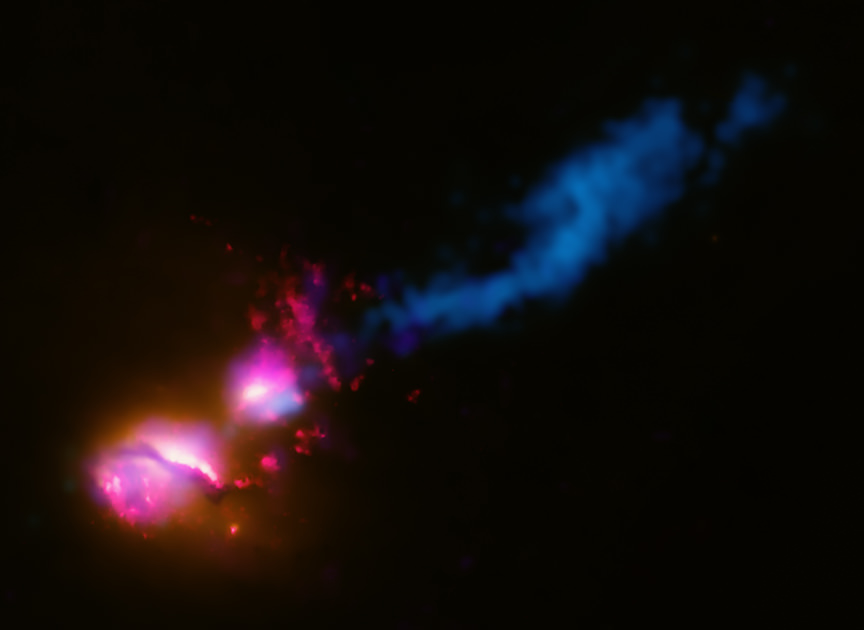Here’s this week’s image for the Where In The Universe Challenge, to test your visual knowledge of the cosmos. You know what to do: take a look at this image and see if you can determine where in the universe this image is from; give yourself extra points if you can name the instrument responsible for the image. We’ll provide the image today, but won’t reveal the answer until tomorrow. This gives you a chance to mull over the image and provide your answer/guess in the comment section. Please, no links or extensive explanations of what you think this is — give everyone the chance to guess.
UPDATE: Answer is now posted below.
This is a composite image from Chandra, Hubble, VLA and MERLIN that shows the jet from a black hole at the center of a galaxy striking the edge of another galaxy, which in 2007, was the first time such an interaction has been found. This system, known as 3C321, is located in the constellation Serpens, and is about 1.4 billion light years from Earth. X-ray data from Chandra shows up in purple; optical and ultraviolet (UV) data from Hubble are seen as red and orange, and radio emission from the Very Large Array (VLA) and MERLIN (Multi-Element Radio-Linked Interferometer Network at Jodrell Bank) in blue show how the jet from the main galaxy on the lower left is striking its companion galaxy to the upper right. The jet impacts the companion galaxy at its edge and is then disrupted and deflected, much like how a stream of water from a hose will splay out after hitting a wall at an angle. Find out more about the image at the Chandra website.
Check back next week for another


I know I’ve seen this one before. It’s a star hurtling through space leaving gas in its wake.
Mira?
Composite color image of 3C 321 (w-jet plowing into unlucky companion galaxy) by Hubble, Chandra & VLA.
This is 3C 321, a pair of galaxies, where one galaxy is in the path of a SMBH induced jet produced by the other. This is also a Chandra-Hubble composite.
Woe to any planetary inhabitants of the second galaxy getting hosed by this jet!
LC
I’m sort of riding on Jon’s coat tails and saying this is the “Death Star” galaxy, with the super massive black hole 3C321 assaulting a near by galaxy and giving us quite a show via Chandra (purple=xray), Hubble (red & orange=UV) and The VLA along with MERLIN (blue=radio).
M87 jet
M87.
This is obviously a merger of exposures from telescopes looking at different wavelengths. The blue is almost certainly to be from Chandra. The rest of it is in IR/Optical, with the IR data from Spitzer. I’ll take a shot in the dark and say that the optical data was from the Hubble.
It’s here
*link deleted*
3C 321 – death star!
mspck…
Please read the last sentence of the blog article written by Nance 🙂
3C321. Easy to remember and such a beautiful and scary picture.
I LOVE IT. It’s a composite of X-ray, optical and radio light. I am not quite sure about the telescopes, but what the heck. The picture speaks for itself.
On the left there is the active galaxy shooting out that blue jet. And that jet crashes into the second galaxy, ripping apart and destroying everything that comes too close by. If there has been any planet in the second galaxy, and that planet happened to contain life, at least the life if not the entire planet are no more!
Destruction and violence in its most extreme form.
Beautiful and scary. The universe is great!
I love this pic!
This is apparently equivilant to that of C567 eclipsed over a large mass of star dust. This galaxy is nearing it’s final days. It’s explosion will ultimately be devistating due to the suffocating effects of the 7 niner niner engulfing the galaxy. This picture was taken by the HUBBLE. ]====>
This photo is of a large explosion between interstellar mass inside the Orion arm of the Milky Way and solar winds extending from the C758. The dust created by the Crab Nebula is such a great amount of mass that the reaction with the dark matter enclosing the system is visible on the M15 side of the picture (the blue cloud).
It is an image of an underwater volcanic eruption, from a vent near the edge of the Juan de Fuca plate off the Oregon coast. The submarine or ROV taking the photo has turned off it’s lights. The violet glow is the lava extruding from two spots, and the blue haze is “smoke”.
Volcano, but I’m not guessing which.
I fail.